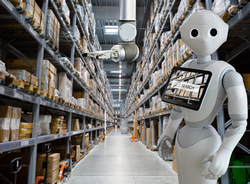Nathan Cairns* suggests several ways in which automation can make the public sector a happier and healthier place to work.
 With the ever-present possibility of spending cuts, Government Departments will focus sharply on cutting costs and increasing efficiency.
With the ever-present possibility of spending cuts, Government Departments will focus sharply on cutting costs and increasing efficiency.
Yet cost-cutting does not have to come at the expense of employee engagement or the citizen experience.
Many Government Departments still rely on manual, time-consuming tasks that, while essential, are not overly inspiring for heavily-burdened staff.
We need a way to plug the gaps — and automation could hold the answer.
Working in the public sector and helping to improve people’s livelihoods is hugely rewarding. However, burnout is an ever-present challenge.
A study by mental health charity, Mind warned that public sector workers are more than a third more likely to say their mental health is poor than workers in the private sector.
The United Kingdom has seen widespread industrial action in the public sector.
Disputes over working conditions and pay have involved Royal Mail employees, rail workers, healthcare staff, and teachers.
Retaining and recruiting talent in the public sector is a hard task, made even harder by the fact the public sector cannot always compete with the private sector on wages.
Compounding these issues is that some Government areas still rely on manual, sometimes even paper-based workflows.
Completing the same unfulfilling tasks day in, day out contributes to low morale, poor work quality, and burnout — and may even push employees to search for more rewarding work.
When employees’ time is absorbed with repetitive administrative tasks, their career development suffers too, as this time could be spent on upskilling.
A recent study by McKinsey found that 41 per cent of employees said that a lack of career development was the main reason they had resigned from a job.
This is where intelligent automation (IA) can help.
IA combines robotic process automation (RPA), artificial intelligence (AI), and intelligent business management systems to automate repetitive workflows and reimagine operations and processes.
Robots can work without a coffee break, completing tasks 24/7 without boredom, fatigue, or human error, while bringing cost savings and improved data accuracy to organisations.
A robotic support system can help Departments in several ways.
Firstly, automating mundane tasks can improve employee satisfaction and free up skilled workers to focus on more valuable work.
Secondly, it can reduce costs while delivering at scale, as new robots can be added to the workforce as needed.
Thirdly, it can enable Departments to transform services to improve the citizen experience.
Here are three areas where leveraging IA can free employee time and enable the public sector to deliver a better, more streamlined service to citizens.
Digital contact centres and self-service
Between applying for benefits payments, submitting requests for planning permission, or making tax inquiries, contact teams are often inundated with requests from the public.
With stretched teams and nine-to-five hours, this can mean simple requests and forms can sometimes take weeks to action, creating undue stress for citizens.
Even though the information they need is often on a website, it can be hard to find.
Creating digital contact centres and enabling self-service through online for submissions can help Departments to shift the majority of enquiries away from phone and email to chatbots and FAQs.
This significantly reduces inbound enquiries, increases speed of resolution for the public, while helping staff to focus on more complex cases.
Human Resources’ on-boarding and off-boarding
Another area where IA can help to free up employee time is in automating manual back-office processes around employee on-boarding and off-boarding.
Given the type of information and services the Government delivers, there is a greater need for checks and balances.
However, this can be time-consuming and does not give a slick impression to new starters.
Workflow automation can help to streamline these processes, ensuring employees are on-boarded quickly with everything they need, helping to set the right impression from day one.
Streamlining invoice processing
Managing relationships with suppliers and vendors can be time-consuming and complex, from on-boarding suppliers, and issuing purchase orders to processing invoices.
Using IA, finance teams can complete these intensive and repetitive tasks more quickly and accurately.
IA enables them to easily verify and extract unstructured data to process vendor invoices faster, which alleviates a significant amount of manual effort and creates a more streamlined service.
Retaining talent
Intelligent automation is a powerful tool that organisations can use to not only retain their talent, but also enhance employees’ daily experiences at work.
It’s important to remember that when IA is implemented in an organisation effectively, it doesn’t replace jobs; it adds value.
When they are not manually performing time-consuming, automatable tasks, employees’ time is freed up to focus on training opportunities — helping to build their confidence in their skills and enhance career development.
The public sector should look to embrace IA to benefit not just their organisation but also to drive a better employee experience.
IA can shift employees’ time away from automatable work — and engaged staff pay dividends in loyalty, productivity, and retention.
*Nathan Cairns is Head of Intelligent Automation Practice at Kainos Group, a Northern Ireland-based software company that develops information technology for businesses and organisations.
This article first appeared on the Open Access Government website.











